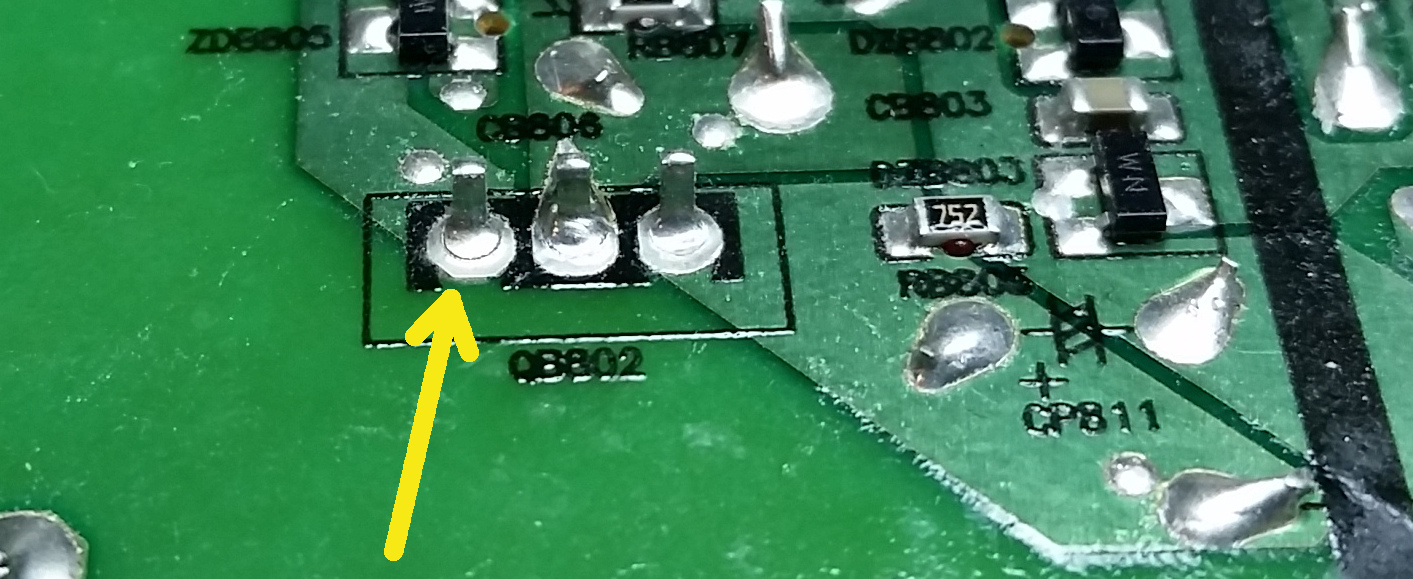Warning!
 Be extra careful while working on power supplies.
Especially the broken ones can be very dangerous!
It is obvious that the power supply carries dangerous voltages when the TV is connected to the mains voltage.
Be extra careful while working on power supplies.
Especially the broken ones can be very dangerous!
It is obvious that the power supply carries dangerous voltages when the TV is connected to the mains voltage.
But what is less obvious is that dangerous voltages can still be present on the capacitors of the power supply PCB when the mains voltages has been removed.
So make sure that the main filter capacitor has been properly discharged before poking around on the power supply PCB.
The main filter capacitor can easily be found, it's simply the biggest one, and is often 400V rated.
Checking the charge on it can simply be done with a voltage meter.
Make sure the voltage on the capacitor is near 0V before doing any repairs.
Do not use your screwdriver to discharge it though.
Although it will generate some spectacular sparks the discharge current can be high enough to ruin your screw driver and kill the mains filter cap in one blow.
I always use an old fashioned light bulb to discharge big capacitors.
Samsung LE26A456C2DXXC Repair
Gone are the days that you could fix almost any problem inside a TV with just a bunch of basic electronic spare parts. But don't despair, there is still a reasonable chance that you can fix LCD TVs, despite their heavy integration.
When this TV came in with the problem of refusing to be switched on I immediately thought about the infamous capacitor problems.
I'm sure you've seen some on power supply PCBs before.
They are the ones with the cracked seals on top.
These are a dead giveaway of the cause of the problem.
Much to my surprise all the caps on this power supply looked just fine though.
Caps which look fine are no guarantee that they are good, so I started taking them out for a checkup.
Unfortunately they were all still in good shape.
This is unfortunate because now I had to try to find the cause of the problem somewhere else.
And it's been a while since I've quit the consumer electronics business, thus apart from the bad caps, I do not have much experience in repairing TVs any more.
So I asked a friend who might know a bit more about these things.
His tip was that the TV might have a broken back light inverter transformer.
If one is broken the TV will go into protection mode and refuses to switch on.
These transformers can easily be checked with an Ohm meter.
There are 6 of them and they should all measure just about the same.
Alas, the transformers were all the same. The fault must be somewhere else.
Eureca
After another close inspection of the power supply PCB I saw something suspicious. In the picture below I've marked a TO220 device which is glued to the PCB. This glue is there to prevent the device from vibrating, which would crack the solder joints. At least that was the plan I think.

But obviously this plan has failed, as you can see by the close-up of the solder joints of this particular part.

This is actually a common problem with parts which tend to get hot. Their legs tend to expand when the temperature rises, and contract when they cool down again. And when the body of the part is rigidly fixed, either with glue or when it is bolted to a heat sink, the only things that can give way are the solder joints.
This is of course easily fixed be resoldering the solder joints of this TO220 device.
General Rule
It is generally a good idea to check the solder joints of parts which tend to get hot on a PCB. Next to bad capacitors this might as well be the second most common source of problems if the system is not designed properly. Cracked solder joints can easily be prevented by making an S-bend in the leads of the part. That way these leads can expand and retract as much as they like, without putting any strain on the solder joints.
